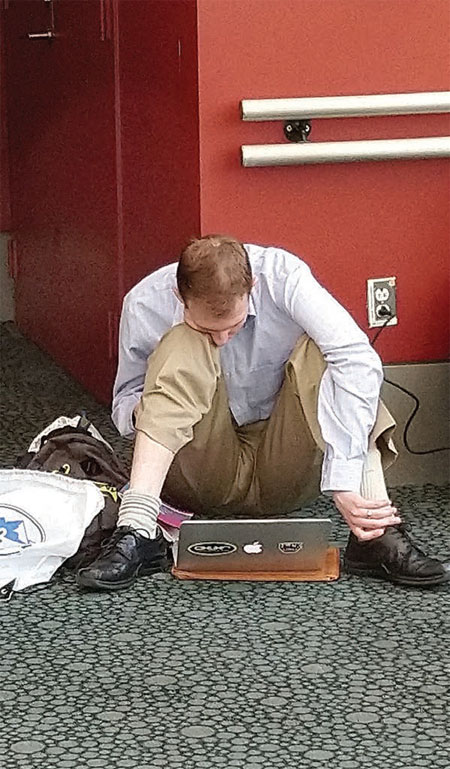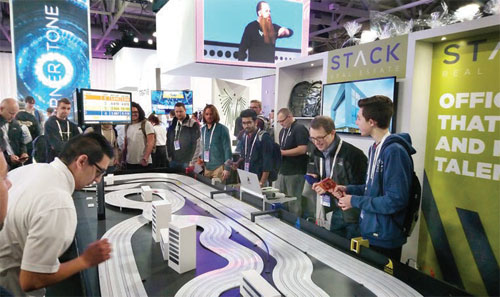Brice Wallace
Silicon Slopes’ push to get computer science in every Utah school was announced last year, but this year, the organization’s leaders have made a huge financial commitment to the effort.
During the recent Silicon Slopes Tech Summit at the Salt Palace Convention Center, five leaders each promised to give $1 million to match funding they hope will be approved by the Utah Legislature during its current general session to improve the pipeline supplying the workforce for the tech industry.{mprestriction ids="1,3"}
Since last year, “we have experienced incredible momentum,” said Aaron Skonnard, CEO of Pluralsight. “In the last 12 months, so much has happened and so much has changed to the point that we’re now confident to declare that we have a state strategy and a commitment by the governor to get computer science in every school across Utah, including rural Utah, by 2022 — four years from now. … And because of what’s happening, I know that this is going to be a reality for our state in four years, and there’s nothing more important to our tech-driven future right here in Silicon Slopes.”
Gov. Gary Herbert’s budget recommendations include $3.9 million for Talent Ready Utah grants to support the expansion of computer science course offerings in Utah secondary schools and aims to offer at least three unique computer science classes in every middle school.

An attendee at the recent Silicon Slopes Tech Summit at the Salt Palace Convention Center takes advantage of a break in the action to check his email in a hallway near the main meeting hall.
HB227, sponsored by Rep. John Knotwell, R-Herriman and also CEO of the Utah Technology Council, calls for the creation of the computer science grant program through Talent Ready Utah and pegs the appropriation at $10 million. As of the middle of last week, the bill had yet to be heard by a legislative committee.
The tech leaders making the $1 million commitment are Skonnard; Josh James, CEO of Domo; Dave Elkington, CEO of InsideSales; Ryan Smith, CEO of Qualtrics; and Todd Pedersen, a Silican Slopes executive board member and CEO of Vivint.
“I’ve been building tech companies here for a while and obviously one of the challenges is always finding more engineers. … We’re actually pretty good at producing children in our state — we’re best in the country at that. In terms of always making sure they’re computer science-educated, [it] hasn’t been so great,” James said. “I wanted my kids to take computer science. It’s not offered. That’s why I’m excited about it and passionate about it.”
“No state has been able to do it,” Smith said. “Everyone wants to do it. It makes sense. No one’s been able to do it, and we’re going to be the first one.”
“What we’re trying to do is say, ‘We believe in this state,’” Pedersen told the crowd. “We believe in the future of the state. The state needs to innovate when it comes to education, and all of you are needing this to happen so that you have future employees that you’re going to employ and they’re going to drive this economy in the state. …
“So, we’re just up here saying, ‘We believe, and we’ll do it,’ and we’re trying to put a little bit of pressure on the Legislature to make this happen, and you need to help us do that.”
“This is happening on a grassroots basis already,” Elkington said. “We’re not going to get there with grassroots. We have to do this at scale. And I agree with Ryan: Let’s be the first state to do this. Let’s show the rest of the country and the rest of the world what it’s like to empower our kids for the future.”
Lt. Gov. Spencer Cox said that only 53 percent of Utah high schools offer a computer science class, and only about 30 percent have an advanced placement computer science offering. “We just have so, so far to go,” Cox said.
“It’s not mandatory,” Herbert said of the proposed computer science offerings that would be expanded, “but it will be an option so that people can see the opportunities out there and the benefit it would be to have that kind of a skillset as they go on to college, technical college and career opportunities.”
The governor said a workforce gap exists because 500,000 jobs are open in the technology sector but only about 50,000 are being filled. That’s a 10-percent rate, but Utah’s is even lower, at about 7 percent, he said.
“Clearly, as we’ve extended our STEM education programs, technology is really the lynchpin to so many jobs and virtually every industry has some need for technology.
“We need to provide opportunities for our young people to understand and appreciate there’s a great career out there if you look at computer technology, so we’re trying to make sure that that’s an option out there available for them. … It’s needful to have something that lines up, really, with the growing demand in the global marketplace, and computer science is that area.”
Cox said it’s a cliché to say that every company is a tech company, “but it also happens to be true.” He talked about tech being used by dairy farmers to milk cows, determine whether the milk is good and how much food the cows have eaten, and the truck driving industry has been changing with advances in GPS and automation.
“It’s not just Silicon Slopes,” Cox said. “It’s everywhere, and if our kids are not prepared for that — that change in the global economy — we’re going to be in a world of hurt five years from now, 10 years from now. Actually, we’re kind of in a world of hurt right now with the gap that the governor mentioned.”
Carine Clark, a member of the Silicon Slopes executive board and CEO at Banyan, said Silicon Slopes is committed to having computer science in every school by 2022 “not just because it’s the right thing to do, but because we have to.”
“By 2026, there will be 1.1 million open jobs in technology,” she said. “In our current pipeline of college students, master’s students — so, six years — we can only fill 45 percent of those jobs, and it’s going to be a problem not just for Utah, not just for the United States, but for the world, because as the No. 1 economy on the planet, it matters.”{/mprestriction}








